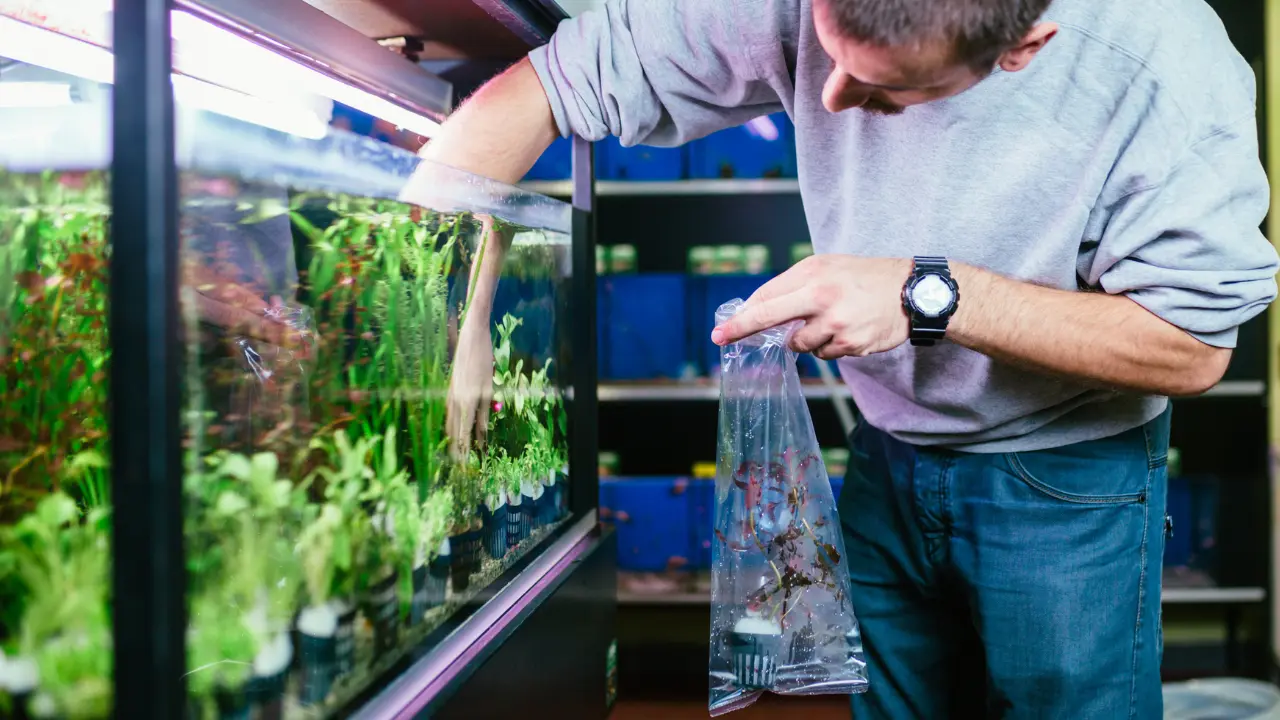As aquarists, we understand the importance of your pet’s health. Today we will discuss Fish tuberculosis, a menacing disease for fish and humans. In this article let’s explore all you need to know to defend your fish and yourself against fish TB.
Do you know what causes this deadly disease? how can it affect both humans and fish? Let’s answer that in a minute, till then here’s what we will cover today.
Today we will cover, what is Tuberculosis, its symptoms, its causes, and how you prevent it. We will also discuss how humans can catch this disease from a fish and how to avoid this from happening. So, without any further ado, let’s dive in.
But before we start let me answer your thoughts: Yes! Humans can catch tuberculosis from fish as similar bacteria cause TB in fish and humans. To avoid this, read the article below and secure your fish and yourself.
What Is Fish Tuberculosis?
Fish tuberculosis is also known as piscine tuberculosis or just TB. This is a bacterial infection that affects fish and humans alike. A specific bacteria called Mycobacterium marinum causes this disease. Unfortunately, this disease is as deadly to humans as to freshwater and marine fish. Moreover, this disease is highly contagious, so humans and tankmates can catch it from an infected fish.

TB affects the internal organs of the fish while multiplying rapidly. This leads to the formation of granulomas, which are small inflammation patches. In these small patches, the immune system tries to contain and fight the infection.
Over time, this infection worsens the fish’s immune system and ultimately causes death!
In fish, tuberculosis can cause weight loss, lethargy, and skin ulcers. Moreover, the Infected fish can also get skeletal deformities and scale loss. The most intriguing fact about this bacteria is that it can survive in a wide range of environments. Thus, killing it is hard, and saving the fish is harder. The best way to dodge this bullet is to avoid it in the first place. For that make sure you provide a stress-free and hygienic tank environment to your fish.
This disease is threatening to humans as well, although it isn’t deadly! Due to TB, the tank goes through a condition called fish tank granuloma. Whenever you put your bruised or cut hand in this infected tank, the bacteria enter the wound. Any sort of wound will be a direct target leading to painful lesions. These lesions are slow-healing wounds that might cause significant pain.
Symptoms of Fish Tuberculosis
Symptoms of Fish TB can vary from fish to fish however, here we will discuss the most common ones. These symptoms might be subtle at first but over time they grow severe causing a significant change in the fish’s behavior.

- Lethargy: The infected fish will become sluggish and inactive. It will spend most of its time resting at the tank bottom.
- Loss of appetite: The affected fish will lose interest in eating and in some cases might refuse to eat at all.
- Weight loss: Due to a lack of food intake and physical movement, the fish will become weaker and lose weight.
- Skin ulcers: The affected fish will get bruises and lesions all over the body. Usually, these appear as red or white patches.
- Fin erosion: Infected fish will have decayed and bruised fins. They will lose all their grace leading to a dull and frayed look.
- Skeletal deformities: Some fish might have deformed body structures. Usually, this includes an abnormally curved spine, bent fins, and an abnormal jaw in the fish.
- Aggressive behavior: Fish affected by TB can get irritated and might attack tankmates.
- Isolation: The fish will hide in caves and avoid interaction with tankmates.
- Respiratory distress: The infected fish can feel discomfort while breathing. moreover, you can observe rapid or labored breathing.
- Buoyancy issues: Fish with Buoyancy may experience issues like swim bladder disease. The fish will fail to maintain its position in the tank and stay afloat.
Moreover, due to TB, the fish’s internal organs start to fail which causes significant changes in activity and behavior. So, it’s crucial to monitor the fish for any symptoms of Tuberculosis, and if found, immediately seek a vet.
Fish TB Causes
Wondering: How do fish get tuberculosis ? Mainly Poor tank maintenance and dirty tank water are the reasons behind a TB breakout. Infrequent water changes or bad water filtration make the perfect breeding ground for bacteria. One of these bacteria includes Mycobacterium marinum, which causes Tuberculosis.

In addition, stress is the last nail in the coffin! Overcrowding, incompatible tank mates, and poor diet weaken the fish’s immune system. Ultimately making the fish susceptible to Fish Tuberculosis. In addition, if tank mates nibble on a dead fish with TB then they will probably get TB as well.
But that’s not all, sometimes a new tankmate can be the reason. When you add a new fish to the tank, always make sure you quarantine and sanitize it. Otherwise, it can bring in TB bacteria, E.coli, salmonella, and whatnot in the tank.
Moreover, sanitize your hands or use proper gloves before handling the fish. Your hands can carry many unwanted additions to the tank as well.
How to Treat Fish TB
When it comes to treating infected fish, early detection is key. If you spot the symptoms in an early phase, you could help the fish recover. However, if you are late, it could be lethal for the fish.

- First of all, Tuberculosis is extremely contagious as it spreads like wildfire. So, isolate your fish in a separate tank.
- After isolating your fish, provide supportive care like providing ideal tank conditions.
- Consult a veterinarian as soon as possible. Follow the medications and routine as prescribed by the vet.
In addition, you could use medications like kanamycin and rifampicin. These medications can keep the bacteria from spreading. Moreover, to keep the tank clean and sanitized, consider using the following products
While there is no solid cure for this disease, providing supportive therapy and extra care could be helpful. Always consult with a professional before providing any medication.
In addition, if one fish in a tank gets fish Tuberculosis, it means all the fish in the tank are affected. So, it’s normal to see random death of fellow fish that didn’t show TB symptoms. Don’t add new fish in a tank if any fish from that tank is or was affected by fish Tuberculosis.
Preventing Fish Tuberculosis
To prevent tuberculosis breakouts, maintain a pristine aquarium. Everything that goes in and out of the tank must be monitored and sanitized. Use a high-quality water filter and keep the water parameters under control. It’s best to use a water test Kit to maintain safe nitrate levels, pH levels, and ammonia concentrations.

Always Quarantine new fish before you add it to your tank. This will allow you to monitor the fish and detect any illness or abnormal behavior.
Lastly, avoid overcrowding the tank as this can stress out the fish. Moreover, maintain a healthy diet and feeding routine for the fish. All in all, keep your fish healthy and provide ample space. This way their immune system will be strong, allowing them to fight Tuberculosis and prevent it in the first place.
Can Humans Catch TB from Fish?
Humans can catch tuberculosis from fish but it’s not as deadly as it is for the fish. The bacteria that cause TB in fish and humans aren’t the same but they belong to the same genus, thus they are similar.
For the fish, this sort of TB can be deadly. It causes organ failure, skin and fin damage, and even skeletal deformities. While for humans, it only causes infection that leads to skin lesions and pain. Moreover, these lesions occur on a specific spot like the hands or the arms. Fish Tuberculosis symptoms in humans include red or purple bumps, nodules, or ulcers on hands and arms.

Generally, this infection doesn’t spread. However, it might damage surrounding skin and tissue if left untreated.
You should always wear gloves when dealing with fish or tanks that might be affected by fish Tuberculosis. Always remember that this disease can only occur through cuts and bruises. In case you do get infected, use antibiotics like doxycycline or clarithromycin. However, visiting the doctor might be a good option before using any medication.
How does a Vet Treat Fish Tuberculosis
As discussed above, there is no specific cure for Fish with tuberculosis. However, professionals might help your fish by operating and removing certain infected organs. But in general, if you have a small-sized fish, your fish will die eventually.
But if you have a larger fish, it might be possible to save it. The vets will perform surgery to take samples. Using these samples, they can identify the disease and figure out the severity of the case. However, the chances of the fish’s survival are still very low.

Here’s what the doctors will do
First of all, your fish will be observed and symptoms will be identified. If the doctor suspects the fish to have TB, the process will continue.
The doctor will collect samples from the fish by skin scraping, biopsy, or necropsies. These samples will help the doctor in performing tests.
The collected samples will be examined for the presence of Mycobacterium marinum. This will clear out any uncertainty and the results will decide whether your fish has TB or not.
For performing this test, the samples might undergo PCR testing.
Treatment if your fish has TB
Doxycycline or Enrofloxacin are antibiotics that will be administered. However, the fish will have to be isolated in a separate tank for prolonged periods

If the fish does not show signs of recovery, the doctors will suggest euthanizing it. This is the only practical decision as the fish will only endure pain if left untreated. This decision is hard but it will guarantee the safety of other tankmates.
After that, you should Thoroughly clean and disinfect the tank. This will reduce the risk of re-infection.
We understand that this decision is hard but it is for the greater good. Unfortunately, in some situations, there are no solutions and you have to make a choice.
How you can sanitize the tank
After dealing with the infected fish, you must clean the infected tank. Here is how you can deep clean the contaminated tank.

Firstly, thoroughly clean all the equipment that was in the tank. All the equipment is considered infected so it must be sanitized.
After that, start scrubbing the tank walls, gravel, decorations, and equipment with a soapy solution. Let it sit for some time then give the tank a thorough rinse.
The next step is to disinfect everything with an antiseptic solution. For this, you should use a diluted solution that has approximately 1 part bleach to 9 parts water. You can also use Lysol instead of bleach.
Add this solution to the tank and let it sit for at least 15-20 minutes before rinsing with clean water. Make sure all the bleach is out.
It’s best to dispose of the things that can be replaced. However, to keep the tank and the equipment in useable condition, follow the above-given cleaning guide.
FAQ’s
Is fish TB dangerous to humans ?
Yes! Fish Tuberculosis can be dangerous to humans. However, fish TB in humans isn’t as dangerous as it is for the fish. If you have a bruise or cut on your hand, refrain from submerging it in an infected tank. Otherwise, you might get painful lesions that heal very slowly.
What does fish TB look like ?
Infected areas might show signs of inflammation, red or purple bumps, and ulcers. These are very painful lesions that might not heal easily.
Is fish TB contagious to other fish ?
Yes! TB is a bacterial infection that can be very contagious. If a fish has TB, it should be immediately isolated in a separate tank. Even after that, there is always a high chance that the tank and tankmates are contaminated.
What are Fish TB causes ?
Fish TB is caused by a bacteria called Mycobacterium marinum. However, these bacteria don’t come out of nowhere. The main causes for TB outbreaks include poor tank conditions, a stressful environment in the tank, and the addition of un-sanitized tank mates.
Is TB in Betta fish more common ?
No! TB can target betta fish but it isn’t more common as compared to other fish. Betta fish are equally susceptible to Tuberculosis as other fish are.
Conclusion
So that was all about Fish Tuberculosis and its effects on fish and humans. In this article, we discussed what Fish TB is, what causes TB, and how you can prevent it. Moreover, we also explored how it can affect humans and fish. In addition, we covered its possible treatments and what you can do as a fish keeper.
If you have suggestions on preventing Fish Tuberculosis from entering the fish tank, share them with us in the comments below!
In essence, now you have the knowledge required to combat this disease. In addition, you also know how to prevent it from entering your divine aquarium. If you still have any questions, shoot us a comment.

